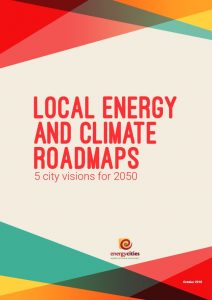New publication out: Five city visions for 2050
Local energy and climate roadmaps and how they change it all
The EU is currently designing a new 2050 strategy for reducing its GHG emissions, which should be in line with the Paris climate agreement. Many European cities have already engaged in this crucial long-term exercise. Check out our new publication that shines the light on 5 exemplary local energy and climate roadmaps for 2050!
Going beyond energy and climate policies in long-term roadmaps
On the surface, developing a mid-century energy and climate roadmap appears as an undertaking solely focusing on energy and climate policies. Yet, it is much more than that. Thinking about 2050 today leads us to ask ourselves: how should our cities look like by then? How can we achieve a high quality of life, while respecting our planet’s boundaries? How will we share responsibilities and benefits to ensure social and economic wellbeing for all in the city?
Transforming urban economies, energy systems and societies together
Many cities in Europe are already answering these questions for themselves. By developing and implementing their 2050 local energy and climate roadmaps now, they are demonstrating their forward-thinking. These cities are laying out clear pathways to transform their economies, energy systems and societies, together with all actors on their territory. Their landing point in 2050 may be different, but how to get there is remarkably similar: mobilising citizens, addressing all sectors and sharing responsibilities and benefits among all local players.
Embark on the inspiring 2050 journeys of 5 cities with our new publication
In our new study “Local energy and climate roadmaps: 5 city visions for 2050”, Energy Cities showcases the mid-century roadmaps of five exemplary European cities. Embark on the inspiring journeys taken by our member cities Grenoble (France) and San Sebastián (Spain), as well as Manchester (UK), Münster (Germany) and Salzburg (Austria). These European cities demonstrate that acting now with ambition and cooperation for 2050 is possible and beneficial for catalysing the transformation of urban economies, energy systems and societies.



